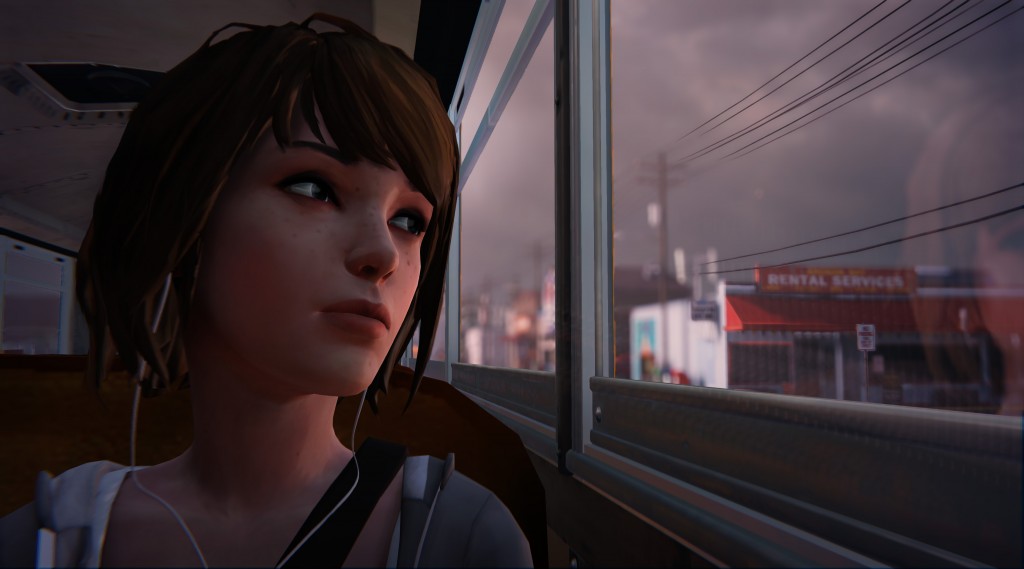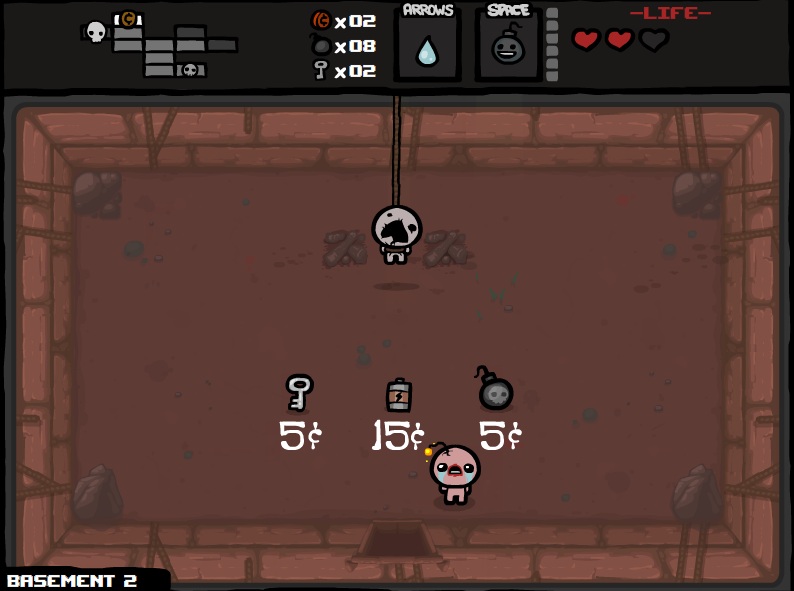Life Is Strange is shaping up to be one of the most innovative games around right now, but the innovation is so invisible and well crafted that you might not even see it. Dontnod’s sophomore effort is taking the dramatic episodic adventure to all new levels with the second installment, “Out of Time,” but without talking to other players, watching streams, or reading reactions, players may not be aware of just how much every little move seems to matter as the narrative builds.
Before I discuss spoilers — and I will, a lot of them (but I’ll warn you before I start) — I want to talk about the game in a general sense, and specifically address the writing (again). I explored narrative and character development in Life Is Strange, among other games, a few weeks ago, and my recent time with Dying Light gave me some fresh perspective. I don’t want to stray too far from the topic here, but Dying Light’s protagonist, Kyle Crane, is a field agent dropped into a zombie-infested city to complete a very specific task. He seems strong and is presented as capable, but because Techland wanted a learning curve and RPG elements, this field agent starts the game fairly weak and unable to run far without getting tired (though he hang on to a ledge with one hand and leap sideways to another ledge no problem!).
For me, this constitutes a narrative breach, a breakdown of internal logic. This may not be as important to some players, for whom the mechanics are more important than story, but for a player like me, invested in narrative and character and how these ideas work with mechanics, this kind of logical break prevents me from developing a real attachment to the game. Nothing makes sense, so what’s the payoff? Just jumping around? Fun, but not enough fun. I shelved it.
I mention this because Life Is Strange skirted close to this line for me in the first episode and I worried that would become even worse in the second episode. Max, who is going through some truly extreme shit, seemed so unaffected — unless it was convenient for the linear moments, and then she was more affected — and the game was so focused on introducing players to the time-rewinding mechanic that a very real danger Max said she was concerned, even panicky about, was shelved in favor of practicing her powers and earning brownie points with a favored teacher. I found moments like that so distracting that I considered waiting to play episode 2. Even as a player vessel, I didn’t have a good sense of who Max was, or what mattered to her; I knew she was oblivious to Warren’s feelings for her, but more than willing to let him take a beating for her; I knew she could watch Chloe get shot without recognizing her, but could recognize her immediately from behind the wheel of a truck. I knew she took selfies, but I didn’t know what she saw in herself, and it felt so lacking at times that I almost considered waiting to play Episode 2.
I’m glad I didn’t, because what I discovered is a story that is starting to come together. There are still some issues here — fetch quests and possibly the weirdest shooting sequence I’ve played in a long time, some bits of dialogue that sounds a little forced, and a list of teen angst tropes as long as a selfie stick (if there’s a problem that exists, somewhere, some student at Blackwell has it), but at the same time, Dontnod is taking on the self-obsessions, passions, and struggles of adolescence head on. The exploration of bullying in the digital age feels so real and emotional here, partly because of the way it’s handled through gameplay, and the player’s ability to study and interact with so many people and things deepens the experience into something that is more than the sum of its parts, and much of that groundwork was laid in Episode 1. Looking back, I appreciate it more as foundation, and by the end of this episode, I cared about people, a lot of them. I also no longer trusted anyone, and as the credits rolled, I found myself counting weeks so I could best speculate on the release frame of episode 3.
Reader, I was hooked in a way no game has hooked me in some time. The problems not only seem less, but I begin to wonder if some of them, at least, are not there by design, to help build characters; it’s something I found myself considering repeatedly during my playthrough. Maybe the game is stronger in that sense now that we know more, or maybe it’s just that I’ve had time to build a narrative for Max in my head, but whatever the reason, the narrative is tightening and the characters are beginning to feel more rounded. Even the fetch quest I grumbled so much about during my playthrough serves a purpose in forcing the player to explore a little… though I think the quiet moments of friendship are equally revealing, and those, along with free exploration, help build empathy and attachment more than these more traditional “quest” moments. I wonder, though, if there was some concern many players would not explore unless forced — which is a good justification, and mimics another important moment in Episode 1, when we’re sent wandering through Chloe’s house after tools.
But as for my words on developing character, it’s not that I think that every game has to have this sort of depth of story and development (I don’t need to know why I’m taking over the world in Civilization; it’s just how we do), but when a game is built on it, shouldn’t it make sense? Shouldn’t the threads pull together? I’m starting to believe they will here, in this game, but the oddly emotionless moments in the first episode and the clunky gameplay sequences in this second piece get in the way. If I’m questioning why Chloe must absolutely have bottles when she is in a junkyard and thus surrounded by junk ready to be destroyed, I’m less focused on learning everything the junkyard has to offer.
I’m quibbling. I know it, I confess it. I think, at this point, I’m too afraid of my emotional attachment here. I want so badly for this game to be what it’s promising that I’m trying to harden myself, just in case. Because what I really want to discuss this time is not the story, which is becoming an engaging mystery, or the specific gameplay elements, but instead the big things: structure and design. Or rather, the ambition of Dontod here, and the “hella epic” thing they are doing, as Chloe might say. All right — from this point on, spoilers about. You’ve been warned.
Choices matter here, and not in the “Clementine will remember that” sort of way that leads you down a path only to find the story was essentially the same all along. There are some major, affecting plotlines in Episode 2 that result in wildly different outcomes, outcomes that leave you, at episode end, with a significant character either alive or dead, and no sense of what will come of that beyond the many mysteries of Blackwell: Kate Marsh, Rachel Amber, Nathan Prescott and sexual assault, and the school’s suspicious faculty and staff.
From the game’s start, Kate Marsh is in crisis. As we learned in the first episode, a video has been released depicting the devout student having a little too much fun at a party, and the video has spread so much that even Kate’s family has seen it. With nowhere to go, and no way to remove all the videos, Kate makes the decision to end her life… and a powerless Max must attempt to save her. But this is a depowered Max, a Max who’s been playing with time all day, a bleeding, helpless Max who has to struggle to find the right things to say to a young woman in pain. What do you say when you can’t rewind? What have you seen, and what do you remember? What do you know of scripture? It may all matter, and it may all send Kate Marsh over the edge to her death.
As I was playing, I was lucky enough to have a viewer in my stream who’d already finished the episode, so when I managed to save Kate, he mentioned he hadn’t been able to. In his game, she’d died. He said it was one of the most devastating moments he’d ever witnessed in a game.
A whole character, just gone? And maybe because we chose mothers instead of fathers. Maybe it was the bacon omelette. Whatever it was, for those players, this episode ended with Kate Marsh dead, while for me and some others, our last view of Kate was in a hospital bed, ostensibly recovering from her ordeal.
 Obviously, this is a big change, huge even, but there are a lot of little things worth noting as well. If you save Kate, there’s no police officer in the principal’s office during the sequence that immediately follows the roof. While the officer doesn’t do anything but stand there in the videos I’ve seen, he was not there at all in my game, which seems to confirm that Dontnod is not just replacing characters, as the Walking Dead did, swapping one person out for another, or swapping quick scenes, as some players see a memorial to Kate while others see her in a hospital bed, but actively designing the game differently for different playthroughs. This gives me hope that from here, we will see vastly different narratives for different players. Before I watched videos and began talking to other players, I was convinced that Kate would probably die regardless, in some other way, to bring the narratives back on track, but that small detail of the police officer gives me hope that they’re going to run with it.
Obviously, this is a big change, huge even, but there are a lot of little things worth noting as well. If you save Kate, there’s no police officer in the principal’s office during the sequence that immediately follows the roof. While the officer doesn’t do anything but stand there in the videos I’ve seen, he was not there at all in my game, which seems to confirm that Dontnod is not just replacing characters, as the Walking Dead did, swapping one person out for another, or swapping quick scenes, as some players see a memorial to Kate while others see her in a hospital bed, but actively designing the game differently for different playthroughs. This gives me hope that from here, we will see vastly different narratives for different players. Before I watched videos and began talking to other players, I was convinced that Kate would probably die regardless, in some other way, to bring the narratives back on track, but that small detail of the police officer gives me hope that they’re going to run with it.
But it’s clear from the ending sequence that Kate is the most recent in a long line of targets, though for what or by whom we can’t say for certain. Her fate may yet change, but the one thing that does seem to stay the same is that setup — the file, the pictures, the pill bottles. I haven’t see anything different in anyone else’s game, so perhaps that means the narrative, for now, is finished with Kate Marsh, for better or for worse. The file, in a sense, is closed. If that’s the case, there won’t be significant difference in the next episode; it will be like the police officer in the office, and the memorial. Things will be there or not. Lines of dialogue will be changed. Interactions may be affected based on choices made in the principal’s office after the incident on the roof.
Then again… what about character reaction? Regardless of the ending, we do see an affected Victoria in the ending montage. It’s likely the students of Blackwell will be frightened and confused regardless of whether or not Kate dies, but will we see those emotional levels flex and changed based on the narratives players have constructed? Just how different will future episodes be for individual players?
But the huge question of whether Kate lives or dies isn’t the only thing of note in terms of narrative branches in this episode, and as the story builds; it’s just the most dramatic and affecting. For instance, in the principal’s office, my first instinct was to blame Kate’s actions on Nathan; he’s the most immediate danger, and I wanted him removed. In my game, that got me suspended, since I had been so apparently rebellious, pending further investigation. For others, the same selection ended with Nathan suspended indefinitely; they, I assumed, had reported the gun, or hadn’t claimed responsibility for Chloe’s weed. I rewound and blamed David Madsen instead, which seemed to lead to a promise of an investigation; in another playthrough I watched, the same action led to Max being accused of a penchant for lies — based again, I would guess, one whether or not the player had reported Nathan’s gun in Episode 1. When Life is Strange tells you something’s going to have consequences, pay attention — it’s not just for show.
There are other differences, though, and not just how you find the bottles in the junkyard fetch quest or what events you choose to witness throughout the episode. There are at least two different ways to solve the crisis of Chloe getting stuck on the train tracks, and possibly a third; while watching another playthrough, I caught a glimmer of something — an axe? — that I’ll investigate on my replay. In every video I’ve seen, and with everyone I talked to, players broke into the shed, got the pliers, cut the wires, and shifted the train, likely because that’s that the game seemed to suggest. I didn’t; I used the crowbar to release a cable spool that took out the apparatus altogether (you can see it here, from my stream, with thanks to MrNinjaSquirrel for reminding me I could run).
I find this intriguing for a few reasons: first, because I want more realism in my games in general (something I’ve explored multiple times), and realistically, there’s usually more than one way to solve a problem. In games, however, players are often tasked with finding object X and manipulating it in way Y, or following some other pattern. I even complained about this tendency in my stream, because I didn’t know until after that there were multiple options. But because there are other options, in this moment, Life Is Strange allows you to use the environment in a way that makes sense. Of course, this further complicates my feelings about the “get me bottles because there’s nothing else in a junkyard we can shoot,” but this level of creativity and player choice in a sequence like the train problem surprises and delights me. It’s exactly what I want in a game.
But these branches may have larger implications beyond simply allowing the player to choose how to solve a puzzle. If you snip the wire and switch the tracks, Chloe pulls herself free, and after the train passes, the two young women hug. In my game, however, I had to pull Chloe free — something more personal and intimate — and Max and Chloe didn’t hug. Instead, Max hovers and pats while Chloe complains a little that there might have been a better way. These differences are small, but I can’t help but wonder if they won’t be as important as whether or not we leave the junkyard with a gun after seeing Frank. I keep thinking about Chloe, and trying to figure out which moments with her are good and which are bad is as difficult as trying to make sense of the myriad connections between Kate Marsh and Rachel Amber.
I keep thinking, too, of Beyond: Two Souls, in which an entire sequence involving a threatened sexual assault can be skipped, something many players didn’t even realize. I didn’t, when I first played; I kept going because it felt like that was what I was supposed to do, what the game wanted me to do, when I should have done the smart thing and simply left. There are other moments like this, too, in Beyond, little shifts that can change whole sequences, invisible choices that create branches based solely on a player’s approach. This, for me, I thought, was the pinnacle; an adaptive, reactive narrative. In Life Is Strange, we’re reminded, constantly, that some actions will have consequences, even small ones… but there’s a lot of detail and opportunity that isn’t signposted in such a way. I don’t think I would have been able to save Kate if I hadn’t seen some messages from her family, and I wonder now, after watching other videos, if not finding something in Samuel’s workspace is going to cause a gap in Max’s understanding of events.
With Beyond, we were encouraged by developers to just experience the game once and let events stand, but the driving mechanic in Life Is Strange, Max’s time-bending ability, encourages, and sometimes even requires, that we play and replay, consider and reconsider, until that power is stripped away and we are left on a rooftop, trying desperately to reach someone who has been so ostracized that reaching her may not be possible. Dontnod is taking cues here from Quantic Dream, from Telltale, from fans and players, and considering everything that’s come before, but the final product of Life Is Strange is uniquely their own, and despite my criticisms, at this point? I’ll follow them wherever this game leads, and then on to the next.






6 thoughts on “When Everything Matters: Branching Narratives in Life Is Strange”
Yes. All the yes.
Wow I had no idea there was so much that could change in this game. I just assumed everyone’s play through would be very similar to mine with some tiny changes. The “illusion of choice” as I like to call it that happens in most games. I hope dontnod keeps it up and I hope other games follow suit.
It was pretty astounding, Crystal. Alisha was watching me do my play through tonight and not only did the events change but the actual dialogue choices changed as well. Pretty impressive that they could pull it off.
Yeah, one thing I noticed while watching recorded playthroughs is that people all seemed to assume that, for instance, the major ending event was set no matter what you did. We just don’t expect this level of flexibility and adaptation in games! When I started digging, I was amazed.
Was pretty cool watching your stream and seeing all the alternate outcomes I had no idea existed. I’m so used to how Telltale does choices (clear forks, small differences leading to the same outcome) that I didn’t even think LiS would be any different. If all these branching paths can actually hold up and be expanded upon until the end of the season, that’ll be noteworthy in and of itself.
So glad to see you again and talk about this again, because having you in the stream similarly deepened my experience. Was good to see you last night, too!
I’m dying for episode three because I cannot wait to see how this plays out. There are a lot of ways it could go that preserve the branching without creating whole new narratives, but just trying to separate all those possibilities in my mind is staggering in and of itself. Like, I wasn’t ready; I assumed what happened, happened. This huge shift between outcomes is a real game(lol) changer.